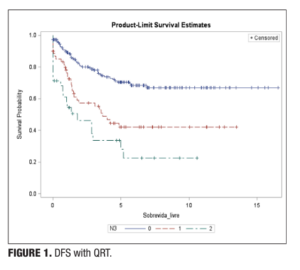HIGHLIGHTS
- Assessment of the lymph nodes during pathological analysis of the surgical specimen is crucial to determine treatment and prognosis.
- Neoadjuvance therapy reduces the number of lymph nodes, being lower than recommended, therefore the lymph node ratio can be an alternative analysis for a better prognosis.
ABSTRACT – Background –
To evaluate the relationship between the ratio of affected lymph nodes (LNR) and clinical and anatomopathological variables in patients with rectal adenocarcinoma submitted or not to neoadjuvant chemoradiotherapy. Methods – The LNR was determined by dividing the number of compromised LNR by the total number of LNR dissected in the surgical specimen. Patients were divided into two groups: with QRT and without QRT. In each group, the relationship between LNR and the following variables was evaluated: degree of cell differentiation, depth of invasion in the rectal wall, angiolymphatic /perineural invasion, degree of tumor regression and occurrence of metastases. The LNR was evaluated in patients with more than 1, LNR (LNR >12) or less (LNR<12) in the surgical specimen with overall survival (OS) and disease-free survival (DFS). The results were expressed as the mean with the respective standard deviation. Qualitative variables were analyzed using Fisher’s exact test, while quantitative variables were analyzed using the Kruskal -Wallis and Mann-Whitney tests. The significance level was 5%. Results – We evaluated 282 patients with QRT and 114 without QRT, between 1995–2011. In the QRT Group, LNR showed a significant association with mucinous tumors (P=0.007) and degree of tumor regression (P=0.003). In both groups, LNR was associated with poorly differentiated tumors (P=0.001, P=0.02), presence of angiolymphatic invasion (P<0.0001 and P=0.01), perineural (P=0.0007, P=0.02), degree of rectal wall invasion (T3>T2; P<0.0001, P=0.02); Compromised LNR (P<0.0001, P<0.01), metastases (P<0.0001, P<0.01). In patients with QRT, LNR<12 was associated with DFS (5.889; 95%CI1.935–19.687; P=0.018) and LNR>12 with DFS and OS (17.984; 95%CI5.931–54.351; P<0.001 and 10.286; 95%CI 2.65439.854; P=0.007, respectively). Conclusion – LNR was associated with histological aspects of poor prognosis, regardless of the use of QRT. In the occurrence of less than 12 evaluated LNR, the LNR was associated only with the DFS.
AUTORES
Laura CREDIDIO, Carlos Augusto Real MARTINEZ, Daniéla Oliveira MAGRO, Rita Barbosa de CARVALHO, Maria de Lourdes Setsuko AYRIZONO and Cláudio Saddy Rodrigues COY.


